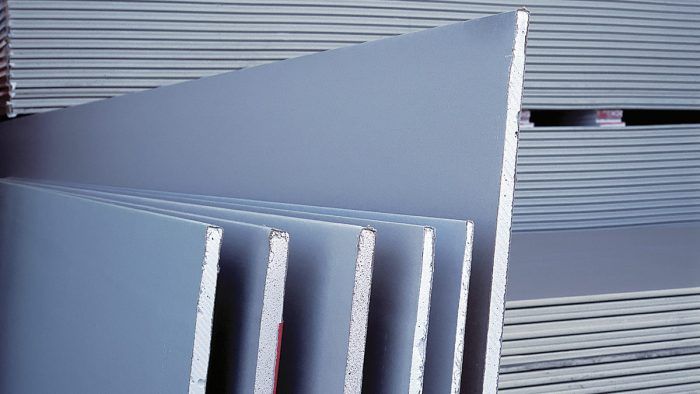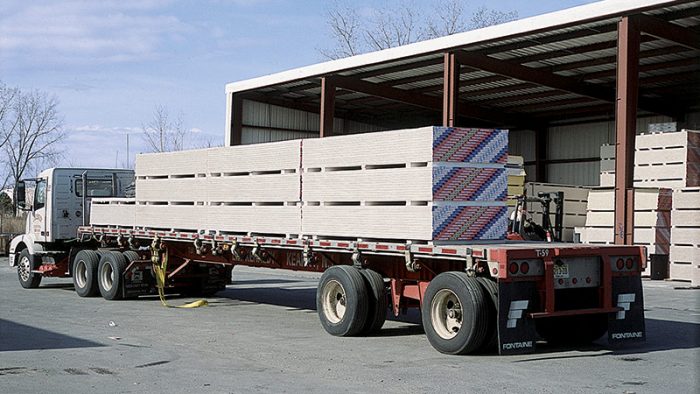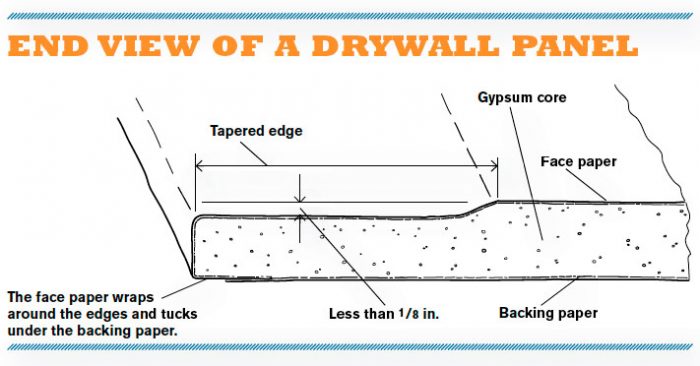An Introduction to Drywall
Available in an ever-growing range of types and sizes, drywall is the preferred surface for walls and ceilings in residential construction.

During the 1940s and 1950s, prefabricated drywall panels gradually replaced plaster as the material of choice for finishing interior walls and ceilings. The earliest drywall panels were used to replace the lath backing in plasterwork; they were narrow (16 in. wide) and only 3/8 in. thick. Today, drywall comes in a wide variety of lengths, thicknesses, and special-use materials. The low cost and the large, easy-to-attach panels make drywall the preferred choice over conventional plaster.
A sheet of drywall consists of a hardened gypsum core sandwiched between two layers of paper—a strong, smooth-finished paper on one side (the face) and a rougher, “natural” paper on the back (see the drawing “End View of a Drywall Panel”). The face paper is folded around the long edges, which are tapered slightly to accommodate joint tape and compound after the panel is installed. The ends of the panel are cut square and finished smooth, leaving the gypsum core exposed.
Plaster-and-lath construction adds a lot of moisture to a building, and plastered surfaces are traditionally left to dry for up to two weeks (depending on humidity, temperature, and airflow) before being decorated. By comparison, drywall has a low moisture content and the joint compounds used to finish the panels cover only a portion of the exterior, rather than the entire surface, so they dry in 24 hours or less—hence the name “drywall.” Drywall is known by many other names, as well, such as Sheetrock (a brand name), gypsum board, plasterboard, wallboard, and gypsum drywall.
Drywall provides excellent sound control, structural integrity, and fire resistance. It is easy to decorate and serves as a good base for paint, wallpaper, paneling, textured finishes, decorative fabric, and vinyl wall coverings. The generic term drywall refers to a number of different types of panels, each with characteristics that make it suitable for specific residential and commercial applications.

Types and Uses of Drywall
When most people think of drywall, they probably picture the standard 4×8 panel that has been in use since drywall first became popular. But this is by no means the only size or type of drywall available today. Panels come in lengths of up to 16 ft. and in 48-in. and 54-in. widths. A wide variety of special-use drywall is also available, including moisture/mold-resistant, fire-resistant, and abuse-resistant panels; 1/4-in. flexible panels; 1/2-in. high-strength ceiling panels; and foil-backed panels. There is also a lighter-weight drywall, and a new type of drywall that takes volatile organic compounds (VOCs) out of the air, creating healthier environments. In the sections that follow, I’ll guide you through the various types and their uses, the thicknesses and lengths available, and the framing specifications for each one. With this information, you’ll be able to make the right decision about which type of drywall to order when it comes time to plan a job.
Why Use Drywall?Regardless of the type, all drywall panels have common characteristics that make them more suitable for wall coverings than plaster, plywood, and other materials.
|






View Comments
That's crazy, I had no idea that some drywall panels come in as big as 16 feet and 54 inches wide. I guess it's somewhat easier to repair drywall patches if they are made that big.
Very interesting discussion, love what's being said. My business drywall repair here at Burleson really appreciate the insights.
Yeah, you're right! this is very interesting. My team from Chicago drywall installation also loves this page!
Such an amazing drywall introduction blog.
Thanks, I'll be able now to make the right decision about which type of drywall to order. Because to be honest, I really had no idea about that but, I know a team of professional who is experts when it comes in drywall repair, you can also contact them.
Very interesting blog for me as an owner of basement finishing business.
Knowing this will benefits us all. Thank you very much for sharing!
Thanks for the article! We don't do much large-scale internal communication at our waterproof foundation service in San Francisco, but I'll keep this in mind as we continue to expand our workforce.
Very interesting. But let me share amazing services when it comes to home remodeling repair like Arlington drywall installation
I was so glad when I started to understand drywalling when I put up my painting company. Helped so much! - house painting
Good afternoon, We are a foundation leak repair service based out of Miami. I just wanted to thank you for the write up, every home owner should know these. You’ll definitely get back what you put in when it comes to home improvement!
And every foundation contractors should also know these.
Thanks for sharing this important information. We'll have to keep these tips in mind when communicating with employees and contractors in our waterproof basement flooring business company :)
What a wonderfully written article! When it comes to a drywall company London, Ontario we are the local experts. We appreciate reading articles like this one to spread awareness about drywall. Thank you for taking the time to write this, cheers!
Thank you for this article, it's really useful to know the different kinds of drywall. We will have to keep this in mind for our drywall installation as the local experts.
We're also a Barrie drywall company!
Thanks for sharing this important information. We'll have to keep these tips in mind when communicating with employees and contractors in our drywall installation palm bay
Really great article. Tons of great info very useful for our basement renovation and finishing division.
I have been digging articles lately for our our site and lucky enough to find this one! This is very informative indeed. Awesome post you have here, thank you for sharing!
Cheers!
Thank you for the great information you shared. Visalia Fence Company Visalia CA
This is helpful. So that I can learn more, I'm looking for another article that explains the fundamental differences between drywall used in wet areas like bathrooms and kitchens. Like green board or MMR. Thanks.
Such a great quality intro to learning about drywall. We've worked with a lot of clients when their basements get water, lot's of water damaged drywall to say the least! -Alex, foundation waterproofing
Very impressed with this articles depth. solarpanelswinnipeg.com
wow rally nice i like it thank u. Sarkari Naukri